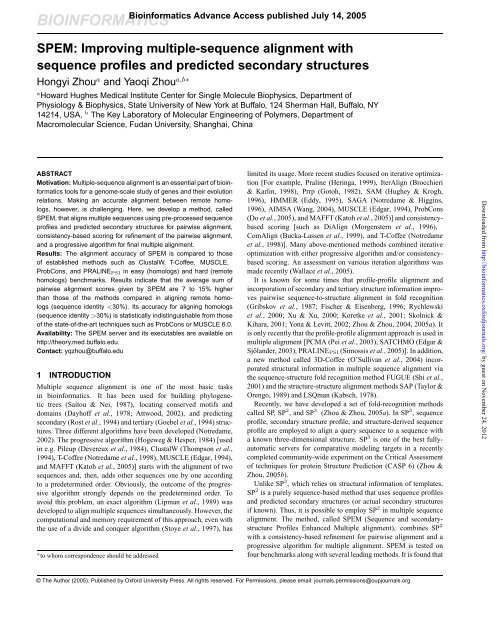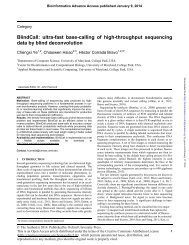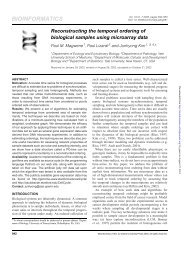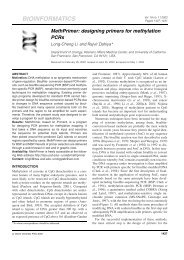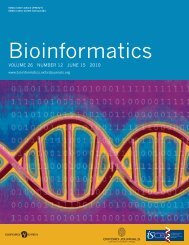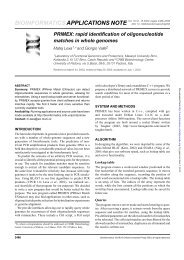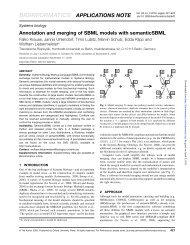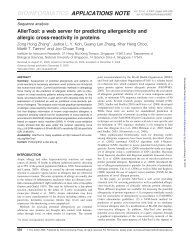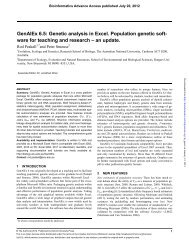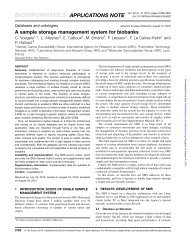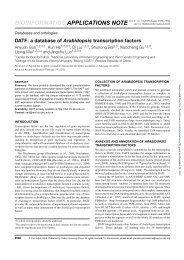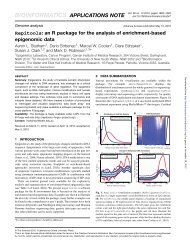SPEM: improving multiple-sequence alignment with sequence ...
SPEM: improving multiple-sequence alignment with sequence ...
SPEM: improving multiple-sequence alignment with sequence ...
Create successful ePaper yourself
Turn your PDF publications into a flip-book with our unique Google optimized e-Paper software.
BIOINFORMATICS<br />
<strong>SPEM</strong>: Improving <strong>multiple</strong>-<strong>sequence</strong> <strong>alignment</strong> <strong>with</strong><br />
<strong>sequence</strong> profiles and predicted secondary structures<br />
Hongyi Zhou a and Yaoqi Zhou a,b∗<br />
a Howard Hughes Medical Institute Center for Single Molecule Biophysics, Department of<br />
Physiology & Biophysics, State University of New York at Buffalo, 124 Sherman Hall, Buffalo, NY<br />
14214, USA, b The Key Laboratory of Molecular Engineering of Polymers, Department of<br />
Macromolecular Science, Fudan University, Shanghai, China<br />
ABSTRACT<br />
Motivation: Multiple-<strong>sequence</strong> <strong>alignment</strong> is an essential part of bioinformatics<br />
tools for a genome-scale study of genes and their evolution<br />
relations. Making an accurate <strong>alignment</strong> between remote homologs,<br />
however, is challenging. Here, we develop a method, called<br />
<strong>SPEM</strong>, that aligns <strong>multiple</strong> <strong>sequence</strong>s using pre-processed <strong>sequence</strong><br />
profiles and predicted secondary structures for pairwise <strong>alignment</strong>,<br />
consistency-based scoring for refinement of the pairwise <strong>alignment</strong>,<br />
and a progressive algorithm for final <strong>multiple</strong> <strong>alignment</strong>.<br />
Results: The <strong>alignment</strong> accuracy of <strong>SPEM</strong> is compared to those<br />
of established methods such as ClustalW, T-Coffee, MUSCLE,<br />
ProbCons, and PRALINEPSI in easy (homologs) and hard (remote<br />
homologs) benchmarks. Results indicate that the average sum of<br />
pairwise <strong>alignment</strong> scores given by <strong>SPEM</strong> are 7 to 15% higher<br />
than those of the methods compared in aligning remote homologs<br />
(<strong>sequence</strong> identity 30%) is statistically indistinguishable from those<br />
of the state-of-the-art techniques such as ProbCons or MUSCLE 6.0.<br />
Availability: The <strong>SPEM</strong> server and its executables are available on<br />
http://theory.med.buffalo.edu.<br />
Contact: yqzhou@buffalo.edu<br />
1 INTRODUCTION<br />
Multiple <strong>sequence</strong> <strong>alignment</strong> is one of the most basic tasks<br />
in bioinformatics. It has been used for building phylogenetic<br />
trees (Saitou & Nei, 1987), locating conserved motifs and<br />
domains (Dayhoff et al., 1978; Attwood, 2002), and predicting<br />
secondary (Rost et al., 1994) and tertiary (Goebel et al., 1994) structures.<br />
Three different algorithms have been developed (Notredame,<br />
2002). The progressive algorithm (Hogeweg & Hesper, 1984) [used<br />
in e.g. Pileup (Devereux et al., 1984), ClustalW (Thompson et al.,<br />
1994), T-Coffee (Notredame et al., 1998), MUSCLE (Edgar, 1994),<br />
and MAFFT (Katoh et al., 2005)] starts <strong>with</strong> the <strong>alignment</strong> of two<br />
<strong>sequence</strong>s and, then, adds other <strong>sequence</strong>s one by one according<br />
to a predetermined order. Obviously, the outcome of the progressive<br />
algorithm strongly depends on the predetermined order. To<br />
avoid this problem, an exact algorithm (Lipman et al., 1989) was<br />
developed to align <strong>multiple</strong> <strong>sequence</strong>s simultaneously. However, the<br />
computational and memory requirement of this approach, even <strong>with</strong><br />
the use of a divide and conquer algorithm (Stoye et al., 1997), has<br />
∗ to whom correspondence should be addressed<br />
Bioinformatics Advance Access published July 14, 2005<br />
limited its usage. More recent studies focused on iterative optimization<br />
[For example, Praline (Heringa, 1999), IterAlign (Brocchieri<br />
& Karlin, 1998), Prrp (Gotoh, 1982), SAM (Hughey & Krogh,<br />
1996), HMMER (Eddy, 1995), SAGA (Notredame & Higgins,<br />
1996), AIMSA (Wang, 2004), MUSCLE (Edgar, 1994), ProbCons<br />
(Do et al., 2005), and MAFFT (Katoh et al., 2005)] and consistencybased<br />
scoring [such as DiAlign (Morgenstern et al., 1996),<br />
ComAlign (Bucka-Lassen et al., 1999), and T-Coffee (Notredame<br />
et al., 1998)]. Many above-mentioned methods combined iterative<br />
optimization <strong>with</strong> either progressive algorithm and/or consistencybased<br />
scoring. An assessment on various iteration algorithms was<br />
made recently (Wallace et al., 2005).<br />
It is known for some times that profile-profile <strong>alignment</strong> and<br />
incorporation of secondary and tertiary structure information improves<br />
pairwise <strong>sequence</strong>-to-structure <strong>alignment</strong> in fold recognition<br />
(Gribskov et al., 1987; Fischer & Eisenberg, 1996; Rychlewski<br />
et al., 2000; Xu & Xu, 2000; Koretke et al., 2001; Skolnick &<br />
Kihara, 2001; Yona & Levitt, 2002; Zhou & Zhou, 2004, 2005a). It<br />
is only recently that the profile-profile <strong>alignment</strong> approach is used in<br />
<strong>multiple</strong> <strong>alignment</strong> [PCMA (Pei et al., 2003), SATCHMO (Edgar &<br />
Sjölander, 2003), PRALINEPSI (Simossis et al., 2005)]. In addition,<br />
a new method called 3D-Coffee (O’Sullivan et al., 2004) incorporated<br />
structural information in <strong>multiple</strong> <strong>sequence</strong> <strong>alignment</strong> via<br />
the <strong>sequence</strong>-structure fold recognition method FUGUE (Shi et al.,<br />
2001) and the structure-structure <strong>alignment</strong> methods SAP (Taylor &<br />
Orengo, 1989) and LSQman (Kabsch, 1978).<br />
Recently, we have developed a set of fold-recognition methods<br />
called SP, SP 2 , and SP 3 (Zhou & Zhou, 2005a). In SP 3 , <strong>sequence</strong><br />
profile, secondary structure profile, and structure-derived <strong>sequence</strong><br />
profile are employed to align a query <strong>sequence</strong> to a <strong>sequence</strong> <strong>with</strong><br />
a known three-dimensional structure. SP 3 is one of the best fullyautomatic<br />
servers for comparative modeling targets in a recently<br />
completed community-wide experiment on the Critical Assessment<br />
of techniques for protein Structure Prediction (CASP 6) (Zhou &<br />
Zhou, 2005b).<br />
Unlike SP 3 , which relies on structural information of templates,<br />
SP 2 is a purely <strong>sequence</strong>-based method that uses <strong>sequence</strong> profiles<br />
and predicted secondary structures (or actual secondary structures<br />
if known). Thus, it is possible to employ SP 2 in <strong>multiple</strong> <strong>sequence</strong><br />
<strong>alignment</strong>. The method, called <strong>SPEM</strong> (Sequence and secondarystructure<br />
Profiles Enhanced Multiple <strong>alignment</strong>), combines SP 2<br />
<strong>with</strong> a consistency-based refinement for pairwise <strong>alignment</strong> and a<br />
progressive algorithm for <strong>multiple</strong> <strong>alignment</strong>. <strong>SPEM</strong> is tested on<br />
four benchmarks along <strong>with</strong> several leading methods. It is found that<br />
© The Author (2005). Published by Oxford University Press. All rights reserved. For Permissions, please email: journals.permissions@oupjournals.org<br />
Downloaded from<br />
http://bioinformatics.oxfordjournals.org/<br />
by guest on November 24, 2012
Zhou and Zhou<br />
Query<br />
Query<br />
Sequence 1 Sequence 2<br />
PSIBLAST<br />
PSIPRED<br />
SP<br />
2<br />
for pairwise <strong>sequence</strong> <strong>alignment</strong><br />
Seq. Profile<br />
Secondary−structure−<br />
dependent Gap<br />
Penalties<br />
2nd. Struc. 2nd. Struc. PSIPRED<br />
Dynamic<br />
Programming<br />
Optimized Seq.<br />
Alignment<br />
Seq. Profile<br />
PSIBLAST<br />
Fig. 1. The flow chart of SP 2 for pairwise <strong>sequence</strong> <strong>alignment</strong>.<br />
<strong>SPEM</strong> improves <strong>alignment</strong> of remote homologs over other leading<br />
methods while maintaining the accuracy of aligning homologs.<br />
2 METHODS<br />
SP2 for pairwise <strong>sequence</strong> <strong>alignment</strong><br />
The method for SP2 (Zhou & Zhou, 2005a) has been described elsewhere.<br />
Here, we give a brief summary for completeness. The algorithm of<br />
SP2 for a pairwise <strong>sequence</strong>-<strong>sequence</strong> <strong>alignment</strong> is shown in Fig. 1. The<br />
details are as follows.<br />
First, the program PSIBLAST (Altschul et al., 1997) is used to search<br />
homologous <strong>sequence</strong>s of a query <strong>sequence</strong> from the NCBI non-redundant<br />
(NR) database (ftp://ftp.ncbi.nih.gov/blast/db/FASTA/nr.gz). As in PSI-<br />
PRED (Jones, 1999), the NR database was filtered to remove low-complexity<br />
regions, transmembrane regions, and coiled-coil segments before being<br />
searched by PSIBLAST. This homolog search is conducted <strong>with</strong> an Evalue<br />
cutoff of 0.001 and completed after three iterations. The homologous<br />
<strong>sequence</strong>s found by PSIBLAST are then filtered by keeping only those<br />
<strong>sequence</strong>s that have less than 98% identity <strong>with</strong> the query <strong>sequence</strong> and<br />
an E-value of less than 0.001. The filtered homologs are used to produce<br />
the <strong>sequence</strong> profile that characterizes evolutionary-derived probability of a<br />
residue type at a given query <strong>sequence</strong> position .<br />
Second, PSIPRED (Jones, 1999) is used to predict the secondary structure<br />
of a query <strong>sequence</strong>. Three states (helix, strand, coil) are used for all<br />
secondary structures.<br />
Third, two query <strong>sequence</strong>s are aligned <strong>with</strong> a total matching score given<br />
by the following equation:<br />
S(i, j) = − 1<br />
2<br />
h<br />
F seq<br />
q1<br />
(i) · Mseq<br />
q2 (j) + Fseq<br />
q2 (j) · Mseq<br />
q1 (i)<br />
i<br />
−w2ndaryδsi,sj + sshift, (1)<br />
where F seq<br />
qk (i) is the <strong>sequence</strong>-derived frequency profile of query <strong>sequence</strong><br />
k (<strong>sequence</strong> profiles described above), M seq<br />
qk (j) is the log odd profile<br />
(position-specific substitution matrix as in PSIPRED) of query <strong>sequence</strong> k<br />
produced by the above mentioned PSIBLAST search against the filtered NR<br />
database, sshift is a to-be-determined constant shift, w2ndary is a weight<br />
parameter for secondary structure profiles, and δsi,sj is a simple function of<br />
the secondary structure element si of query <strong>sequence</strong> 1 at <strong>sequence</strong> position<br />
i and sj of the query <strong>sequence</strong> 2 at <strong>sequence</strong> position j.<br />
j<br />
1 si = sj<br />
δsi,sj =<br />
−1 si �= sj.<br />
Finally, the above-mentioned matching score is optimized by using a<br />
dynamic-programming <strong>alignment</strong> algorithm <strong>with</strong>out penalty to end gaps<br />
(Needleman & Wunsch, 1970). A gap penalty that depends on secondary<br />
structures is employed. No gaps are allowed in helices or sheets (i.e., when<br />
2<br />
<strong>SPEM</strong> for <strong>multiple</strong> <strong>sequence</strong> <strong>alignment</strong><br />
N Sequences<br />
N(N−1)/2 Pairwise<br />
Alignments<br />
Consistency−based<br />
Refinement<br />
Building<br />
Guide Tree<br />
Progressive<br />
Multiple Alignment<br />
.<br />
SP 2<br />
Dynamic<br />
Programming<br />
Neighbor<br />
Joining Method<br />
Dynamic<br />
Programming<br />
Global Multiple Alignment<br />
Consistency−based<br />
Scoring Matrix,<br />
Zero−gap Penalties<br />
Sequence identity−<br />
based Scoring,<br />
Zero−gap Penalties<br />
Fig. 2. The flow chart of <strong>SPEM</strong> for <strong>multiple</strong> <strong>sequence</strong> <strong>alignment</strong>.<br />
si = sj = α or si = sj = β). The gap opening (w0) and gap extension<br />
(w1) penalties are applied to coil regions. However, no gap penalties are applied<br />
to the beginning and the end of <strong>sequence</strong>s (i.e. no end-gap penalties). To<br />
avoid a possible trivial solution of aligning end gaps to whole <strong>sequence</strong>s, a<br />
shift score sshift is used [See e.g. Wang & Dunbrack Jr. (2004)]. Alignment<br />
optimization is to minimize the total <strong>alignment</strong> score due to the negative<br />
signs in Eq. (1).<br />
The above procedure contains four unknown parameters (w0, w1,<br />
w2ndary, and sshift). In the original <strong>sequence</strong>-to-structure <strong>alignment</strong><br />
method SP2 , they were obtained by optimizing the SP2 performance on the<br />
ProSup <strong>sequence</strong>-to-structure <strong>alignment</strong> benchmark where the reference <strong>alignment</strong><br />
is from the ProSup structure-<strong>alignment</strong> program (Domingues et al.,<br />
2000). w0 = 7.8, w1 = 0.18, w2ndary = 0.73, and sshift = −1.30.<br />
Eq. (1) for the <strong>sequence</strong>-<strong>sequence</strong> <strong>alignment</strong> uses a symmetric form for<br />
F seq<br />
qk (i) and Mseq<br />
qk (j) <strong>with</strong> k = 1 and 2. This is slightly different from that<br />
used in the original SP2 for the <strong>sequence</strong>-structure <strong>alignment</strong> (the <strong>alignment</strong><br />
between a query <strong>sequence</strong> and a <strong>sequence</strong> <strong>with</strong> a known structure). The latter<br />
was from the asymmetric equation in the SP3 method (Zhou & Zhou,<br />
2005a) that built on two input <strong>sequence</strong>s having different properties (one<br />
has a known structure and the other does not). The adoption of a symmetric<br />
version in Eq. (1) is to avoid the dependence of the <strong>alignment</strong> result on the<br />
input order of <strong>sequence</strong>s. We found that this symmetric score function gives<br />
essentially the same <strong>alignment</strong> accuracy on the ProSup benchmark (Domingues<br />
et al., 2000) <strong>with</strong> the same optimized parameter values from the original<br />
<strong>sequence</strong>-structure <strong>alignment</strong> method SP2 . Thus, throughout this paper, we<br />
will use this optimized parameter set.<br />
<strong>SPEM</strong> for <strong>multiple</strong> <strong>sequence</strong> <strong>alignment</strong><br />
The above-mentioned SP2 algorithm for pairwise <strong>alignment</strong> is combined<br />
<strong>with</strong> a consistency-based scoring method for refining pairwise <strong>alignment</strong> and<br />
a progressive algorithm for <strong>multiple</strong> <strong>sequence</strong> <strong>alignment</strong>. As illustrated in<br />
Fig. 2, <strong>SPEM</strong> takes following steps for <strong>multiple</strong> <strong>alignment</strong>.<br />
(1) Pairwise <strong>alignment</strong>: Given a set of N <strong>sequence</strong>s, SP2 is used to<br />
produce all N(N-1)/2 pairwise <strong>alignment</strong>s.<br />
(2) Pairwise <strong>alignment</strong> refinement: The SP2 pairwise <strong>alignment</strong> is refined<br />
by using a consistency score. For a given pair of <strong>sequence</strong>s a and b, the consistency<br />
scoring matrix, consab (i, j) = −1 if residue a(i) is aligned <strong>with</strong><br />
b(j) by SP2 , consab (i, j) = 0 if otherwise. This matrix is then updated<br />
based on the <strong>alignment</strong> between a and the third <strong>sequence</strong> c and the <strong>alignment</strong><br />
between b and c by SP2 . If c(k) is aligned <strong>with</strong> a(m) and <strong>with</strong> b(n),<br />
Downloaded from<br />
http://bioinformatics.oxfordjournals.org/<br />
by guest on November 24, 2012
Table 1. Alignment accuracies given by several methods on the BAliBase benchmark for <strong>multiple</strong> <strong>sequence</strong> <strong>alignment</strong>.<br />
Method a<br />
Set 1 -CS d<br />
(82) -SPS e<br />
Set 2 -CS d<br />
(23) -SPS e<br />
Set 3 -CS d<br />
(12) -SPS e<br />
Set 4 -CS d<br />
(12) -SPS e<br />
Set 5 -CS d<br />
(12) -SPS e<br />
All (141) -CS d<br />
p-value f<br />
-SPS e<br />
p-value f<br />
<strong>SPEM</strong> for <strong>multiple</strong> <strong>sequence</strong> <strong>alignment</strong><br />
ClustalW T-Coffee MUSCLE 6.0 ProbCons PRALINEPSI b<br />
<strong>SPEM</strong> c<br />
78.3 80.0 84.7 83.9 83.9 83.9 (82.3)<br />
85.8 86.8 90.3 90.0 90.4 90.8 (89.4)<br />
59.3 58.5 60.9 62.6 61.0 57.3 (52.4)<br />
93.3 93.9 94.4 94.5 94.0 93.4 (93.0)<br />
48.1 54.8 61.9 63.1 55.8 56.9 (52.0)<br />
72.3 76.7 82.2 82.3 76.4 81.4 (78.1)<br />
62.3 76.8 74.8 73.6 53.9 90.8(87.8)<br />
83.4 92.1 91.8 90.9 79.9 97.4 (96.3)<br />
63.4 86.1 92.1 91.7 68.6 92.3 (84.1)<br />
85.8 94.6 98.1 98.1 81.8 97.4 (91.7)<br />
70.0 74.6 78.7 78.4 73.9 78.6 (75.5)<br />
6.0×10 −4<br />
0.067 0.95 0.95 - - (0.014)<br />
85.7 88.2 91.0 90.8 88.2 91.5 (89.8)<br />
8.1×10 −6<br />
4.3×10 −3<br />
0.54 0.16 - - (7.4×10 −3 )<br />
a All results for other established methods (except PRALINEPSI) were done locally <strong>with</strong> their latest versions.<br />
b From Simossis et al. (2005), the p-value for the difference between this method and <strong>SPEM</strong> is not available due to lack of individual<br />
<strong>multiple</strong>-<strong>alignment</strong> results.<br />
c This work. The number in parentheses is the result when secondary structure information is turned off in SP 2 . That is, the SP <strong>alignment</strong><br />
method (Zhou & Zhou, 2005a) rather than SP 2 method is used in <strong>SPEM</strong>.<br />
d CS: Column score, the percentage of whole columns that are aligned correctly.<br />
e SPS: sum-of-pairs score, the percentage of predicted pairwise <strong>alignment</strong>s that are the same as those in the reference <strong>alignment</strong>.<br />
f The p-value indicates the significance of the difference in <strong>alignment</strong> accuracies between <strong>SPEM</strong> and a given method for all datasets. A<br />
p-value of >0.05 indicates a non-significant difference.<br />
consab (m, n) = consab (m, n) − 1. The scoring matrix consab is updated<br />
by analyzing all third <strong>sequence</strong>s. The final scoring matrix consab (i, j) is<br />
used to refine the <strong>alignment</strong> between <strong>sequence</strong>s a and b by using the dynamic<br />
programming technique <strong>with</strong> a zero gap penalty. After this step, we obtained<br />
a refined set of N(N-1)/2 pairwise <strong>alignment</strong>s and pairwise <strong>sequence</strong> identities.<br />
(Shift score and secondary-structure information are used only in SP2 .<br />
They are not used in this refinement step.)<br />
(3) Guide tree: Neighbor joining method (Saitou & Nei, 1987) is used to<br />
construct the guide tree. The distance between two <strong>sequence</strong>s is 1−ID (ID<br />
denotes <strong>sequence</strong> identity). Each time, one joins the two nearest <strong>sequence</strong>s<br />
(or <strong>sequence</strong> groups). The distance between the groups is the average<br />
distance of each pair between the two groups.<br />
(4) Progressive <strong>multiple</strong> <strong>alignment</strong>: Progressive <strong>multiple</strong> <strong>alignment</strong> is performed<br />
based on the guide tree and the refined N(N-1)/2 pairwise <strong>alignment</strong>s<br />
and <strong>sequence</strong> identities obtained above. When two <strong>sequence</strong>s (groups) are<br />
aligned, we first construct a scoring matrix S(I, J) between position I<br />
in Group A and position J in Group B. The contribution of <strong>sequence</strong> a<br />
from group A and <strong>sequence</strong> b from Group B to S(I, J) is Sab (I, J).<br />
Sab (I, J) = (−ID) if <strong>sequence</strong>s a and b are aligned at the two positions<br />
after Step 2. Sab (I, J) = 0 if otherwise. The scoring matrix between<br />
the two groups is the sum of matrices between all possible pairs of the two<br />
groups, i.e., S(I, J) = P<br />
a∈A,b∈B Sab (I, J). Once S(I, J) is obtained,<br />
a dynamic programming algorithm (<strong>with</strong>out any gap penalty) is used<br />
to align the two <strong>sequence</strong>s (groups) <strong>with</strong> scoring matrix S(I, J). The <strong>multiple</strong><br />
<strong>sequence</strong> <strong>alignment</strong> is completed when the guide tree reaches the root.<br />
This procedure produces a global <strong>alignment</strong> of all <strong>sequence</strong>s.<br />
This progressive <strong>multiple</strong>-<strong>alignment</strong> algorithm in the last step is very similar<br />
to that used in the T-Coffee method <strong>with</strong> two exceptions. First, a refined<br />
SP2 pairwise <strong>alignment</strong> is used. Second, the consistency-scoring matrix is<br />
used only in pairwise refinement (step 2) before the progressive <strong>multiple</strong><br />
<strong>alignment</strong> (step 4) but not in the progressive <strong>multiple</strong> <strong>alignment</strong> (Also see<br />
discussion).<br />
It should be emphasized that no new parameter is introduced in combining<br />
SP2 <strong>with</strong> the progressive algorithm.<br />
Test sets and Alignment Accuracy Assessment<br />
<strong>SPEM</strong> is tested on four benchmarks: BAliBase 2.0 (Thompson et al.,<br />
1999), SABmark 1.63 (Walle et al., 2005), Prefab 4.0 (Edgar, 1994), and<br />
a HOMSTRAD dataset of remote homologs (March 10, 2005) (Mizuguchi<br />
et al., 1998). Alignment accuracy is measured by the sum of pairwise<br />
<strong>alignment</strong> score (SPS) – the percentage of predicted pairwise <strong>alignment</strong><br />
that is the same as those in the reference <strong>alignment</strong>. Another score, called<br />
column scores (CS), assesses the percentage of whole columns that are<br />
aligned correctly (Thompson et al., 1999).<br />
p-values are used to estimate the statistical significance of the difference in<br />
<strong>alignment</strong> accuracy between <strong>SPEM</strong> and other established methods. For two<br />
sets of data (x1, x2, ..., xn) and (y1, y2, .., yn), t-value(Press et al., 1992)<br />
is defined as t = √ nD/S, where D (= Pn i=1 (xi − yi)/n) is the average<br />
r Pni=1<br />
(xi−yi−D) difference between x and y and S (=<br />
2<br />
) is the standard<br />
n−1<br />
deviation of the difference. The probability of difference |d| that is greater<br />
than |D|, satisfies the equation P(|d| > |D|) = 1 − I ν (ν/2, 1/2),<br />
ν+t2 where ν = n − 1 is the degree of freedom, I is the incomplete β function.<br />
The probability, called p-value, if found to be 0.05, means a 95% confidence<br />
about the found difference between the two sets of data. The smaller the<br />
p-value is, the higher is the significance level of the difference.<br />
To further analyze the performance of <strong>SPEM</strong>, we also tested the performance<br />
of <strong>SPEM</strong> when secondary structure information is turned off. This is<br />
equivalent to a combination of the SP method for the <strong>sequence</strong>-to-structure<br />
<strong>alignment</strong> (Zhou & Zhou, 2005a) <strong>with</strong> the consistency-based refinement for<br />
pairwise <strong>alignment</strong> and a progressive algorithm for <strong>multiple</strong> <strong>alignment</strong>. The<br />
optimized parameter values from the SP method (Zhou & Zhou, 2005a) is<br />
used in this test. That is, w0 = 6.6, w1 = 0.58, sshift = −0.9 and<br />
w2ndary = 0.<br />
3<br />
Downloaded from<br />
http://bioinformatics.oxfordjournals.org/<br />
by guest on November 24, 2012
Zhou and Zhou<br />
Table 2. Alignment accuracies based on SPS scores given by several methods on the SABmark 1.63 benchmark for <strong>multiple</strong> <strong>sequence</strong><br />
<strong>alignment</strong>.<br />
2 b<br />
Method ClustalW T-Coffee MUSCLE 6.0 ProbCons SP<br />
<strong>SPEM</strong> c<br />
Superfamily (462) 49.9 54.8 54.8 56.2 65.7 67.0<br />
Twilight (236) 21.9 27.4 26.3 29.2 43.5 43.9<br />
All (698) 40.4 45.5 45.2 47.1 58.2 59.2<br />
p-value d<br />
5.6×10 −112<br />
1.5×10 −96<br />
2.3×10 −85<br />
3.8×10 −83<br />
8.3×10 −6<br />
-<br />
a All results for other established methods were done locally <strong>with</strong> their latest versions.<br />
b Pairwise <strong>alignment</strong> by SP 2 , this work.<br />
c Multiple <strong>alignment</strong> by <strong>SPEM</strong>, this work.<br />
d The p-value indicates the significance of the difference in <strong>alignment</strong> accuracies between <strong>SPEM</strong> and a given method for all datasets. A<br />
p-value of >0.05 indicates a non-significant difference.<br />
Table 3. Alignment accuracies based on SPS scores given by several methods on the PREFAB 4.0 benchmark (1682 families).<br />
2 b<br />
ClustalW T-Coffee MUSCLE 6.0 ProbCons SP<br />
Method a<br />
SPS 61.7 69.2 69.6 70.5 77.0<br />
p-value c<br />
3.9×10 −142<br />
2.4×10 −21<br />
1.6×10 −55<br />
4.5×10 −16<br />
-<br />
a All results for other established methods were done locally <strong>with</strong> their latest versions.<br />
b This work. Due to the limitation of computational resource, the results for <strong>SPEM</strong> are not available.<br />
c The p-value indicates the significance of the difference in <strong>alignment</strong> accuracies between <strong>SPEM</strong> and a given method. A p-value of >0.05<br />
indicates a non-significant difference.<br />
3 RESULTS<br />
Test Set 1: BAliBase<br />
BAliBase benchmark (Thompson et al., 1999) contains five reference<br />
sets. Different sets were designed to test different aspects<br />
of <strong>alignment</strong> methods. Set 1 is made of approximately equidistant<br />
<strong>sequence</strong>s; Set 2, a family <strong>with</strong> orphan <strong>sequence</strong>s; Set 3, divergent<br />
families; Set 4, <strong>sequence</strong>s <strong>with</strong> large N/C terminal insertions;<br />
and Set 5, <strong>sequence</strong>s <strong>with</strong> large internal insertions. Reference <strong>alignment</strong>s<br />
are from FSSP (Holm & Sander, 1994) and HOMSTRAD<br />
(Mizuguchi et al., 1998) databases as well as manually constructed<br />
<strong>alignment</strong>s from the literature. All reference <strong>alignment</strong>s are<br />
manually-refined by BAliBase authors. The evaluation of <strong>multiple</strong><br />
<strong>alignment</strong> results is also performed by using the evaluation programs<br />
supplied <strong>with</strong> the benchmark. The average pairwise <strong>sequence</strong><br />
identity of this benchmark is 31.5%.<br />
Table 1 compares the results given by <strong>SPEM</strong> <strong>with</strong> those by<br />
several other methods along <strong>with</strong> the p-values for the difference<br />
in <strong>alignment</strong> accuracy between <strong>SPEM</strong> and a given method for the<br />
overall results. The other methods are two popular methods, ClustalW<br />
(Thompson et al., 1994) and T-Coffee (Notredame et al.,<br />
1998), a profile-profile <strong>alignment</strong> method PRALINEPSI (Simossis<br />
et al., 2005), MUSCLE 6.0 (Edgar, 1994) and the probabilistic<br />
consistency-based method ProbCons (Do et al., 2005). All these<br />
methods (except PRALINEPSI) are run locally <strong>with</strong> default settings.<br />
The results of PRALINEPSI are from Simossis et al. (2005).<br />
<strong>SPEM</strong> outperforms ClustalW and T-Coffee for all sets (3-5% in<br />
SPS scores) except Set 2. For two profile-based methods <strong>SPEM</strong> and<br />
Table 4. Alignment accuracies based on SPS and CS scores given by several methods on the HOMSTRAD dataset of 75 families of remote<br />
homologs.<br />
Method a<br />
SPS 60.7 64.9 66.0 67.7 68.0 74.9 75.5<br />
p-value d<br />
4.9×10 −15<br />
6.7×10 −13<br />
4.1×10 −8<br />
1.4×10 −9<br />
2.7×10 −9<br />
- 0.33<br />
CS 38.8 45.2 44.5 47.7 49.0 55.7 56.9<br />
p-value d<br />
1.9×10 −12<br />
2.2×10 −9<br />
9.6×10 −7<br />
3.0×10 −7<br />
4.3×10 −6<br />
- 0.16<br />
ClustalW T-Coffee PRALINEPSI b MUSCLE 6.0 ProbCons <strong>SPEM</strong> c <strong>SPEM</strong>-DSSP c<br />
a All results for other established methods (except PRALINEPSI) were done locally <strong>with</strong> their latest versions.<br />
b Results from the direct submission to the PRALINEPSI server <strong>with</strong> default setting (http://ibivu.cs.vu.nl/programs/pralinewww/).<br />
c This work. <strong>SPEM</strong>-DSSP is same as <strong>SPEM</strong> but <strong>with</strong> secondary structures extracted from known structures by DSSP.<br />
d The p-value indicates the significance of the difference in <strong>alignment</strong> accuracies between <strong>SPEM</strong> and a given method. A p-value of >0.05<br />
indicates a non-significant difference.<br />
4<br />
Downloaded from<br />
http://bioinformatics.oxfordjournals.org/<br />
by guest on November 24, 2012
PRALINEPSI, the <strong>alignment</strong> accuracy of <strong>SPEM</strong> is similar to that<br />
of PRALINEPSI in Sets 1 and 2 but is significantly better than the<br />
latter in Sets 3, 4, and 5 (5-15% better in SPS scores). The overall<br />
accuracy of <strong>SPEM</strong>, however, is statistically indistinguishable<br />
(based on p-values) from those of the iterative, consistency-based<br />
method ProbCons and the MUSCLE method. It is noted that the<br />
average pairwise <strong>alignment</strong> accuracy is high for all six methods<br />
(between 86% by ClustalW and 92% by <strong>SPEM</strong>). Thus, BAliBase<br />
can be viewed as an “easy” benchmark. Indeed, its average pairwise<br />
<strong>sequence</strong> identity (31.5%) indicates that about half of all<br />
pair <strong>sequence</strong>s are easily detectable homologs (<strong>sequence</strong> identity<br />
>30%).<br />
To have a better understanding of the contribution of secondary<br />
structure information, Table 1 also shows the result when the secondary<br />
structure information is turned off and <strong>SPEM</strong> is a combination<br />
of the method SP <strong>with</strong> consistency-based refinement and a progressive<br />
algorithm. The difference between the methods <strong>with</strong> and<br />
<strong>with</strong>out predicted secondary structures is significant. The difference<br />
is 3% in column score and 2% in SPS score. Similar magnitude of<br />
difference is observed between pairwise <strong>alignment</strong> accuracy given<br />
by SP and that by SP 2 in the SALIGN <strong>alignment</strong> benchmark (Zhou<br />
& Zhou, 2005a).<br />
Test Set 2: SABmark 1.63<br />
SABmark (Walle et al., 2005) (Sequence Alignment Benchmark)<br />
was designed to align the <strong>sequence</strong>s that have low-tointermediate<br />
<strong>sequence</strong> identities (the superfamily set) and very-lowto-low<br />
<strong>sequence</strong> identities (the twilight set) between each other. The<br />
average pairwise <strong>sequence</strong> identity is 22.9% for superfamily set<br />
and 16.9% for twilight set, compared to 31.5% for the BAliBase<br />
benchmark. Thus, it is a more challenging (“harder”) benchmark<br />
than BAliBase. It is also a larger one by covering the entire known<br />
fold space (698 folds). Reference <strong>alignment</strong>s are from consensus<br />
structural <strong>alignment</strong>s by SOFI (Boutonnet et al., 1995) and CE<br />
(Shindyalov & Bourne, 1998). Unlike BAliBase, which provides<br />
reference <strong>multiple</strong> <strong>alignment</strong>s, SABmark supplies only reference<br />
pairwise <strong>alignment</strong>s. As a result, only SPS score is evaluated. [SPS<br />
is called the developer score in SABmark. We omitted the modeler<br />
score (Walle et al., 2005) since it yields essentially the same trend<br />
in relative accuracy among various methods.] The reference pairwise<br />
<strong>alignment</strong>s permit us to evaluate the results of SP 2 in addition<br />
to those of <strong>SPEM</strong>. This makes it possible to examine the effect of<br />
consistency-based pairwise refinement of <strong>alignment</strong> and progressive<br />
<strong>multiple</strong> <strong>alignment</strong>.<br />
Results on the SABmark 1.63 given by ClustalW (Thompson<br />
et al., 1994), T-Coffee (Notredame et al., 1998), MUSCLE 6.0<br />
(Edgar, 1994), ProbCons (Do et al., 2005), and <strong>SPEM</strong> are shown in<br />
Table 2. We did not obtain the results for PRALINEPSI because it is<br />
not feasible to perform such a computationally intensive, large-scale<br />
benchmark test by using a web server. For this “hard” benchmark,<br />
the difference between previously developed methods is relatively<br />
small whereas <strong>SPEM</strong> is 10.8% more accurate in the superfamily set<br />
and 14.7% more in the twilight set than the next best (ProbCons)<br />
according to SPS scores. This demonstrates the exceptional capability<br />
of <strong>SPEM</strong> to align remotely-related <strong>sequence</strong>s. The change<br />
of pairwise <strong>alignment</strong> accuracy from SP 2 to <strong>SPEM</strong> is small (1%)<br />
but statistically significant according to the corresponding p-value.<br />
This indicates that the consistency-based scoring and progressivebased<br />
algorithm implemented in <strong>SPEM</strong> provide some additional<br />
noticeable improvements.<br />
<strong>SPEM</strong> for <strong>multiple</strong> <strong>sequence</strong> <strong>alignment</strong><br />
Test Set 3: PREFAB 4.0<br />
PREFAB 4.0 contains 1682 families (Edgar, 1994). Each family<br />
contains only one pair of <strong>sequence</strong>s <strong>with</strong> known structures. This<br />
pair of <strong>sequence</strong>s are supplemented <strong>with</strong> total up to 50 homologous<br />
<strong>sequence</strong>s obtained from PSIBLAST. Alignment accuracy is<br />
evaluated based on reference structural <strong>alignment</strong> of the pair of<br />
<strong>sequence</strong>s <strong>with</strong> known structures. The average pairwise <strong>sequence</strong><br />
identity is 21.0%. Thus, this benchmark can be considered as a<br />
“hard” benchmark. Each pair of structures are aligned using the<br />
CE aligner (Shindyalov & Bourne, 1998), and only those pairs for<br />
which FSSP (Holm & Sander, 1994) and CE agreed on 50 or more<br />
positions are retained.<br />
Table 3 compares the results given by the pairwise <strong>alignment</strong><br />
method SP 2 <strong>with</strong> four <strong>multiple</strong> <strong>alignment</strong> methods ClustalW,<br />
MUSCLE 6.0, T-Coffee, and ProbCons. We did not carry out <strong>SPEM</strong><br />
or PRALINEPSI for this benchmark because it is too computationally<br />
demanding. For <strong>SPEM</strong>, the accuracy of <strong>SPEM</strong> <strong>multiple</strong><br />
<strong>alignment</strong> is dictated by the accuracy of SP 2 pairwise <strong>alignment</strong><br />
(See Table 2). That is, the <strong>alignment</strong> accuracy of SP 2 is an indicator<br />
for the accuracy of <strong>SPEM</strong>. The average SPS score [called Qscore<br />
in PREFAB (Edgar, 1994)] is 61.7% for ClustalW, 69.2% for T-<br />
Coffee, 69.6% for MUSCLE 6.0, 70.5% for ProbCons, and 77.0%<br />
for SP 2 . The differences in <strong>alignment</strong> accuracy given by SP 2 and<br />
other methods are statistically significant because the p-values for<br />
the differences are very small.<br />
Test Set 4: HOMSTRAD<br />
We also construct a test set based on the HOMSTRAD structural<br />
<strong>alignment</strong> dataset (dated March 10, 2005). In this dataset, the<br />
structural <strong>alignment</strong>s were performed using the programs MNY-<br />
FIT (Sutcliffe et al., 1987), STAMP (Russell & Barton, 1992), and<br />
COMPARER (Sali & Blundell, 1990). These structure-based <strong>alignment</strong>s<br />
are annotated <strong>with</strong> JOY and examined individually (Mizuguchi<br />
et al., 1998). There are 75 families that contain a minimum<br />
of four <strong>sequence</strong>s <strong>with</strong> average <strong>sequence</strong> identity less than or equal<br />
to 25%. This set <strong>with</strong> an average <strong>sequence</strong> identity of 18.7% further<br />
examines the ability of various methods to align remote homologs.<br />
Table 4 compares the <strong>alignment</strong> accuracies given by several<br />
methods. The <strong>alignment</strong> accuracies given by ProbCons, T-Coffee,<br />
MUSCLE 6.0, and PRALINEPSI are similar to each other whereas<br />
<strong>SPEM</strong> is about 7% more accurate (in either SPS or CS) than the<br />
next best (ProbCons). The difference between <strong>SPEM</strong> and all other<br />
methods are statistical significant.<br />
This small benchmark also permits us to investigate the effect of<br />
errors in predicted secondary structures on the accuracy of <strong>SPEM</strong>.<br />
To do this, we test a version of <strong>SPEM</strong> where the secondary structures<br />
used in SP 2 are obtained directly from known structures by<br />
using the program DSSP (Kabsch & Sander, 1983), rather than predicted<br />
by PSIPRED (Jones, 1999). The new version of the method<br />
(labeled <strong>SPEM</strong>-DSSP) uses the parameters of <strong>SPEM</strong>. The results<br />
are shown in Table 4. The average SPS score increases from 74.9%<br />
to 75.5% and the CS score increases from 55.7% to 56.9% after the<br />
exact secondary structures are used. However the differences are not<br />
statistically significant based on p-values. This limited change may<br />
be resulted from the error cancellation in predicted secondary structures<br />
between two query <strong>sequence</strong>s and/or from the high accuracy<br />
(about 80%) in secondary structure prediction by PSIPRED.<br />
To further examine the dependence of different methods on the<br />
difficulty of benchmarks, we expand the 75 families of the HOM-<br />
STRAD benchmark to 233 families by including all <strong>alignment</strong>s <strong>with</strong><br />
5<br />
Downloaded from<br />
http://bioinformatics.oxfordjournals.org/<br />
by guest on November 24, 2012
Zhou and Zhou<br />
Alignment accuracy measured by SPS (%)<br />
100<br />
90<br />
80<br />
70<br />
60<br />
50<br />
40<br />
<strong>SPEM</strong><br />
ProbCons<br />
MUSCLE 6<br />
T-Coffee<br />
ClustalW<br />
10 20 30 40 50 60<br />
Average <strong>sequence</strong> identity (%)<br />
Fig. 3. Alignment accuracies (measured by SPS) as a function of<br />
average <strong>sequence</strong> identity given by methods <strong>SPEM</strong>, ProbCons,<br />
MUSCLE 6.0, T-Coffee, and ClustalW as labeled. Each point is<br />
represented by the lower bound of <strong>sequence</strong> identity at each bin.<br />
more than 3 <strong>sequence</strong>s. These families are binned in every 5%<br />
average pairwise <strong>sequence</strong> identity. More specifically, the bins are<br />
10-15, 15-20, 20-25, 25-30, 30-35, 35-40, 40-45, 45-50, 50-55,<br />
55-60 and 60-65%. The corresponding number of families in each<br />
bin is 11, 38, 26, 34, 36, 32, 22, 15, 19, 4, and 3, respectively.<br />
Here, we focus on families <strong>with</strong> <strong>sequence</strong> identities from 10% to<br />
65% because there are only three families <strong>with</strong> <strong>sequence</strong> identities<br />
between 65-100%.<br />
Fig. 3 plots <strong>alignment</strong> accuracies (measured by SPS) as a function<br />
of average <strong>sequence</strong> identity given by <strong>SPEM</strong>, ProbCons, MUSCLE<br />
6, T-Coffee, and ClustalW. All methods have similar accuracy<br />
when the average <strong>sequence</strong> identity is high. The difference between<br />
various methods is clear when the average <strong>sequence</strong> identity is less<br />
than 30%. Below this point, the <strong>alignment</strong> accuracy of <strong>SPEM</strong> is consistently<br />
better than those of other methods. (PRALINEPSI is not<br />
performed on this extended benchmark due to computational requirement.<br />
One expects that its performance will be similar to those of<br />
MUSCLE 6.0 or ProbCons as suggested by results in Tables 1 and<br />
4).<br />
4 DISCUSSION<br />
In this paper, we combine a recently developed profile-profile<br />
and secondary-structure enhanced <strong>alignment</strong> method <strong>with</strong> a progressive<br />
algorithm for <strong>multiple</strong> <strong>sequence</strong> <strong>alignment</strong>. The method,<br />
called <strong>SPEM</strong>, provides a significant improvement in aligning remote<br />
homologs when compared to the state-of-the-art techniques such as<br />
ClustalW, T-Coffee, ProbCons, MUSCLE, and a profile-profile <strong>multiple</strong><br />
<strong>alignment</strong> method PRALINEPSI. Meanwhile, it also provides<br />
an excellent <strong>alignment</strong> for homologs (statistically indistinguishable<br />
from ProbCons and MUSCLE in the BAliBase benchmark).<br />
6<br />
Profile-profile <strong>alignment</strong> method is the main source for <strong>improving</strong><br />
<strong>alignment</strong> of remote homologs. The use of predicted secondary<br />
structures also contributes the accuracy of <strong>SPEM</strong>. Predicted secondary<br />
structures are responsible for <strong>improving</strong> <strong>alignment</strong> accuracy<br />
by an additional 0.4-5.7% in SPS depending on specific testing sets<br />
in the BAliBase benchmark (Table 1). Employing exact secondary<br />
structures makes minor changes to <strong>alignment</strong> accuracy.<br />
<strong>SPEM</strong>, as PRALINEPSI, is more time-consuming than T-Coffee,<br />
ProbCons, and MUSCLE. It spends most of its computing time<br />
in calculating <strong>sequence</strong> profiles using PSIBLAST. However, the<br />
required computing time is affordable. A <strong>multiple</strong> <strong>sequence</strong> <strong>alignment</strong><br />
of 50 <strong>sequence</strong>s between 100 to 200 residues long takes<br />
about several hours on a single-processor PC. The gain in accuracy<br />
for aligning remote-related <strong>sequence</strong>s significantly outweighs the<br />
increase in computing time. <strong>SPEM</strong> improves over PRALINEPSI in<br />
two benchmarks tested. This may be due to the difference in how<br />
profile-profile <strong>alignment</strong> is made (Wang & Dunbrack Jr., 2004).<br />
Table 2 indicates that <strong>SPEM</strong> provides a small but significant<br />
improvement over the pairwise <strong>alignment</strong> from SP 2 . We have also<br />
tested the combination of T-Coffee <strong>with</strong> the SP 2 pairwise <strong>alignment</strong>.<br />
The combination also yields a similar improvement over the input<br />
pairwise <strong>alignment</strong> but <strong>with</strong> a longer computing time. In addition,<br />
we implemented a procedure for refining <strong>multiple</strong> <strong>alignment</strong> by randomly<br />
partitioning all into two sets for 100 times (Do et al., 2005).<br />
This increased computational time significantly but improved little<br />
in <strong>alignment</strong> accuracy. However, there are many other iterative algorithms<br />
(Taylor & Brown, 1999; Hughey & Krogh, 1996; Edgar,<br />
1994; Katoh et al., 2005; Heringa, 1999; Brocchieri & Karlin, 1998;<br />
Gotoh, 1982; Eddy, 1995; Notredame & Higgins, 1996; Wang,<br />
2004) that are potentially useful to refine the pairwise <strong>alignment</strong><br />
from SP 2 . A recent evaluation of iterative <strong>alignment</strong> algorithms<br />
indicates that iterative algorithms can improve over some methods<br />
but not others (Wallace et al., 2005). Further study in this area is<br />
required.<br />
Another way to improve the accuracy of <strong>SPEM</strong>, as 3D-Coffee<br />
(O’Sullivan et al., 2004), is to take advantage of structural information<br />
if one or more <strong>sequence</strong>s to be aligned in <strong>multiple</strong> <strong>alignment</strong><br />
have known structures. This can be achieved by combination of<br />
SP 2 , SP 3 , and structure-structure <strong>alignment</strong> programs. [For a recent<br />
assessment of various structure-<strong>alignment</strong> techniques, see Kolodny<br />
et al. (2005).] SP 3 will be used to align a <strong>sequence</strong> of unknown<br />
structure <strong>with</strong> a <strong>sequence</strong> of known structure. Benchmark tests<br />
suggested that SP 3 increases <strong>alignment</strong> accuracy by an additional<br />
2-3% over SP 2 (Zhou & Zhou, 2005a). Clearly, more structures are<br />
known, more accurate <strong>multiple</strong> <strong>alignment</strong> will be. We shall defer<br />
this to future studies.<br />
ACKNOWLEDGMENT<br />
We gratefully thank the authors who made their programs and databases<br />
available for comparison. This work was supported by NIH<br />
(R01 GM 966049 and R01 GM 068530), a grant from HHMI to<br />
SUNY Buffalo and by the Center for Computational Research and<br />
the Keck Center for Computational Biology at SUNY Buffalo. Y. Z.<br />
is also partially supported by a two-base grant (No. 20340420391)<br />
from national science foundation of China.<br />
Downloaded from<br />
http://bioinformatics.oxfordjournals.org/<br />
by guest on November 24, 2012
REFERENCES<br />
Altschul, S. F., Madden, T. L., Schäffer, A. A., Zhang, J., Zhang, Z., Miller, W. &<br />
Lipman, D. J. (1997) Gapped BLAST and PSI-BLAST: a new generation of protein<br />
database search programs. Nucl. Aci. Res., 25, 3389–3402.<br />
Attwood, T. K. (2002) The PRINTS database: a resource for identification of protein<br />
families. Brief. Bioinform., 3, 252–263.<br />
Boutonnet, N. S., Rooman, M. J., Ochagavia, M. E., Richele, J. & Wodak, S. J. (1995)<br />
Optimal protein structure <strong>alignment</strong>s by <strong>multiple</strong> linkage clustering: application to<br />
distantly related proteins. Protein Eng., 8, 647–662.<br />
Brocchieri, L. & Karlin, S. (1998) Asymmetric-iterated <strong>multiple</strong> <strong>alignment</strong> of protein<br />
<strong>sequence</strong>s. J. Mol. Biol., 276, 249–264.<br />
Bucka-Lassen, K., Caprani, O. & Hein, J. (1999) Combining many <strong>multiple</strong> <strong>alignment</strong>s<br />
in one improved <strong>alignment</strong>. Bioinformatics, 15, 122–130.<br />
Dayhoff, M. O., Schwartz, R. M. & Orcutt, B. C. (1978) A model of evolutionary<br />
change in proteins. In Atlas of proteins <strong>sequence</strong>s and structure vol. 5,. National<br />
Biomedical Research Foundation, Washington, D.C. pp. 345–352.<br />
Devereux, J., Haeberli, P. & Smithies, O. (1984) GCG package. Nucl. Acids Res., 22,<br />
387–395.<br />
Do, C. B., Mahabhashyam, M. S. P., Brudno, M. & Batzoglou, S. (2005) Probabilistic<br />
consistency-based <strong>multiple</strong> <strong>sequence</strong> <strong>alignment</strong>. Genome Res., 15, 330–340.<br />
Domingues, F. S., Lackner, P., Andreeva, A. & Sippl, M. J. (2000) Structure-based<br />
evaluation of <strong>sequence</strong> comparison and fold recognition <strong>alignment</strong> accuracy. J. Mol.<br />
Biol., 297, 1003–1013.<br />
Eddy, S. R. (1995) Multiple <strong>alignment</strong> using hidden Markov models. In Third international<br />
conference on intelligent systems for molecular biology (ISMB). AAAI Press.<br />
Cambridge England: Menlo Park CA.<br />
Edgar, R. C. (1994) MUSCLE: <strong>multiple</strong> <strong>sequence</strong> <strong>alignment</strong> <strong>with</strong> high accuracy and<br />
high throughput. Nucl. Acids Res., 32, 1792–1797.<br />
Edgar, R. C. & Sjölander, K. (2003) SATCHMO: <strong>sequence</strong> <strong>alignment</strong> and tree<br />
construction using hidden Markov models. Bioinformatics, 19, 1404–1411.<br />
Fischer, D. & Eisenberg, D. (1996) Protein fold recognition using <strong>sequence</strong>-derived<br />
predictions. Protein Sci., 5, 947–955.<br />
Goebel, U., Sander, C., Schneider, R. & Valencia, A. (1994) Correlated mutations and<br />
residue contacts in proteins. Proteins, 18, 309–317.<br />
Gotoh, O. (1982) Significant improvement in accuracy of <strong>multiple</strong> protein <strong>sequence</strong><br />
<strong>alignment</strong>s by iterative refinements as assessed by reference to structural <strong>alignment</strong>s.<br />
J. Mol. Biol., 264, 823–838.<br />
Gribskov, M., McLachlan, A. D. & Eisenberg, D. (1987) Profile analysis: detection of<br />
distantly related proteins. Proc Natl Acad Sci USA, 84, 4355–4358.<br />
Heringa, J. (1999) Two strategies for <strong>sequence</strong> comparison: profile-preprocessed and<br />
secondary-structure-induced <strong>multiple</strong> <strong>alignment</strong>. Computers and Chemistry, 23,<br />
341–364.<br />
Hogeweg, P. & Hesper, B. (1984) The <strong>alignment</strong> of sets of <strong>sequence</strong>s and the<br />
construction of phylogenetic trees. An integrated method. J. Mol. Evol., 20,<br />
175–186.<br />
Holm, L. & Sander, C. (1994) The FSSP database of structurally aligned protein fold<br />
families. Nucl. Acids Res., 22, 3600–3609.<br />
Hughey, R. & Krogh, A. (1996) Hidden Markov models for <strong>sequence</strong> analysis: extension<br />
and analysis of the basic method. Computer Applications in Biological Science,<br />
12, 95–107.<br />
Jones, D. T. (1999) Protein secondary structure prediction based on position-specific<br />
scoring matrices. J. Mol. Biol., 292, 195–202.<br />
Kabsch, W. (1978) A discussion of the solution for the best rotation to relate two sets<br />
of vectors. Acta Cyrstallog. sect. A, 34, 827–828.<br />
Kabsch, W. & Sander, C. (1983) Dictionary of protein secondary structure: pattern<br />
recognition of hydrogen-bonded and geometrical features. Biopolymers, 22, 2577–<br />
2637.<br />
Katoh, K., Kuma, K., Toh, H. & Miyata, T. (2005) MAFFT version 5: improvement in<br />
accuracy of <strong>multiple</strong> <strong>sequence</strong> <strong>alignment</strong>. Nucl. Acids Res., 33, 511–518.<br />
Kolodny, R., Koehl, P. & Levitt, M. (2005) Comprehensive evaluation of protein<br />
structure <strong>alignment</strong> methods: scoring by geometric measures. J. Mol. Biol., 346,<br />
1173–1188.<br />
Koretke, K. K., Russell, R. B. & Lupas, A. N. (2001) Fold recognition from <strong>sequence</strong><br />
comparisons. Proteins, Suppl 5, 68–75.<br />
Lipman, D. J., Altschul, S. F. & Kececioglu, J. D. (1989) A tool for <strong>multiple</strong> <strong>sequence</strong><br />
<strong>alignment</strong>. Proc. Natl. Acad. Sci. USA, 86, 4412–4415.<br />
Mizuguchi, K., Deane, C. M., Blundell, T. L. & Overington, J. P. (1998) HOMSTRAD:<br />
a database of protein structure <strong>alignment</strong>s for homologous families. Protein Sci., 7,<br />
2469–2471.<br />
<strong>SPEM</strong> for <strong>multiple</strong> <strong>sequence</strong> <strong>alignment</strong><br />
Morgenstern, B., Dress, A. & Wener, T. (1996) Multiple DNA and protein <strong>sequence</strong><br />
based on segment-to-segment comparison. Proc. Natl. Acad. Sci. USA, 93, 12098–<br />
12103.<br />
Needleman, S. B. & Wunsch, C. D. (1970) A general method applicable to the search<br />
for similarities in the amino acid <strong>sequence</strong> of two proteins. J. Mol. Biol., 48, 443–<br />
453.<br />
Notredame, C. (2002) Recent progress in <strong>multiple</strong> <strong>sequence</strong> <strong>alignment</strong>: a survey.<br />
Pharmacogenomics, 3, 131–144.<br />
Notredame, C. & Higgins, D. G. (1996) SAGA: <strong>sequence</strong> <strong>alignment</strong> by genetic<br />
algorithm. Nucleic Acids Res., 4, 1515–1524.<br />
Notredame, C., Holm, L. & Higgins, D. G. (1998) COFFEE: an objective function for<br />
<strong>multiple</strong> <strong>sequence</strong> <strong>alignment</strong>s. Bioinformatics, 14, 407–422.<br />
O’Sullivan, O., Suhre, K., Abergel, C., Higgins, D. G. & Notredame, C. (2004)<br />
3DCoffee: combining protein <strong>sequence</strong>s and structures <strong>with</strong>in <strong>multiple</strong> <strong>sequence</strong><br />
<strong>alignment</strong>s. J. Mol. Biol., 340, 385–395.<br />
Pei, J., Sadreyev, R. & Grishin, N. V. (2003) PCMA: fast and accurate <strong>multiple</strong><br />
<strong>sequence</strong> <strong>alignment</strong> based on profile consistency. Bioinformatics, 19, 427–428.<br />
Press, W. H., Teukolsky, S. A., Vetterling, W. T. & Flannery, B. P. (1992) Numerical<br />
Recipes: The Art of Scientific Computing. (2nd Edition). Cambridge University<br />
Press, Cambridge.<br />
Rost, B., Sander, C. & Schneider, R. (1994) PHD-an automatic server for protein<br />
secondary structure prediction. CABIO, 10, 53–60.<br />
Russell, R. B. & Barton, G. J. (1992) Multiple protein <strong>sequence</strong> <strong>alignment</strong> from tertiary<br />
structure comparison. PROTEINS, 14, 309–323.<br />
Rychlewski, L., Jaroszewski, L., Li, W. & Godzik, A. (2000) Comparison of <strong>sequence</strong><br />
profiles. strategies for structural predictions using <strong>sequence</strong> information. Protein<br />
Sci., 9, 232–241.<br />
Saitou, N. & Nei, M. (1987) The neighbor-joining method: a new method for<br />
reconstructing phylogenetic trees. Mol. Biol. Evol., 4, 406–425.<br />
Sali, A. & Blundell, T. L. (1990) Definition of general topological equivalence in protein<br />
structures. a procedure involving comparison of properties and relationships<br />
through simulated annealing and dynamic programming. J Mol Biol, 212, 403–428.<br />
Shi, J., Blundell, T. L. & Mizuguchi, K. (2001) FUGUE: <strong>sequence</strong>-structure homology<br />
recognition using environment-specific substitution tables and structure-dependent<br />
gap penalties. J. Mol. Biol., 310, 243–257.<br />
Shindyalov, I. N. & Bourne, P. (1998) Protein structure <strong>alignment</strong> by incremental<br />
combinatorial extension (CE) of the optimal path. Protein Eng., 11, 739–747.<br />
Simossis, V. A., Kleinjung, J. & Heringa, J. (2005) Homolog-extended <strong>sequence</strong><br />
<strong>alignment</strong>. Nucl. Acids Res., 33, 816–824.<br />
Skolnick, J. & Kihara, D. (2001) Defrosting the frozen approximation:<br />
PROSPECTOR– a new approach to threading. Proteins, 42, 319–331.<br />
Stoye, J., Moulton, V. & Dress, A. W. (1997) DCA: an efficient implementation<br />
of the divide-and-conquer approach to simultaneous <strong>multiple</strong> <strong>sequence</strong> <strong>alignment</strong>.<br />
Comput. Appl. Biosci., 13, 625–626.<br />
Sutcliffe, M. J., Haneef, I., Carney, D. & Blundell, T. L. (1987). Protein Eng., 1,<br />
377–384.<br />
Taylor, W. R. & Brown, N. P. (1999) Iterated <strong>sequence</strong> databank search methods.<br />
Comput. Chem., 23, 365–385.<br />
Taylor, W. R. & Orengo, C. A. (1989) Protein structure <strong>alignment</strong>. J. Mol. Biol., 128,<br />
1–22.<br />
Thompson, J., Higgins, D. & Gibson, T. (1994) CLUSTAL W:<strong>improving</strong> the sensitivity<br />
of progressive <strong>multiple</strong> <strong>sequence</strong> <strong>alignment</strong> through <strong>sequence</strong> weighting positionspecific<br />
gap penalties and weight matrix choice. Nucl. Acids Res., 22, 4673–4690.<br />
Thompson, J. D., Plewniak, F. & Poch, O. (1999) A comprehensive comparison of<br />
<strong>multiple</strong> <strong>sequence</strong> <strong>alignment</strong> programs. Nucl. Acids Res., 27, 2682–2690.<br />
Wallace, I. M., Orla, O. & Higgins, D. G. (2005) Evaluation of iterative <strong>alignment</strong><br />
algorithms for <strong>multiple</strong> <strong>alignment</strong>. Bioinformatics, 21, 1408–1414.<br />
Walle, I. V., Lasters, I. & Wyns, L. (2005) SABmark - a benchmark for <strong>sequence</strong><br />
<strong>alignment</strong> that covers the entire known fold space. Bioinformatics, 21, 1267–1268.<br />
Wang, G. & Dunbrack Jr., R. L. (2004) Scoring profile-to-profile <strong>sequence</strong> <strong>alignment</strong>s.<br />
Protein Sci., 13, 1612–1626.<br />
Wang, Y. Li, K. B. (2004) An adaptive and iterative algorithm for refining <strong>multiple</strong><br />
<strong>sequence</strong> <strong>alignment</strong>. Comput. Biol. & Chem., 28, 141–148.<br />
Xu, Y. & Xu, D. (2000) Protein threading using PROSPECT: design and evaluation.<br />
Proteins, 40, 343–354.<br />
Yona, G. & Levitt, M. (2002) Within the twilight zone: a sensitive profile-profile<br />
comparison tool based on information theory. J. Mol. Biol., 315, 1257–1275.<br />
Zhou, H. & Zhou, Y. (2004) Single-body knowledge-based energy score combined <strong>with</strong><br />
<strong>sequence</strong>-profile and secondary structure information for fold recognition. Proteins,<br />
55, 1005–1013.<br />
7<br />
Downloaded from<br />
http://bioinformatics.oxfordjournals.org/<br />
by guest on November 24, 2012
Zhou and Zhou<br />
Zhou, H. & Zhou, Y. (2005a) Fold recognition by combining <strong>sequence</strong> profiles derived<br />
from evolution and from depth-dependent structural <strong>alignment</strong> of fragments.<br />
Proteins, 58, 321–328.<br />
8<br />
Zhou, H. & Zhou, Y. (2005b) SPARKS 2 and SP 3 servers in CASP 6. Proteins (CASP<br />
Supplement Issue), accepted.<br />
Downloaded from<br />
http://bioinformatics.oxfordjournals.org/<br />
by guest on November 24, 2012


